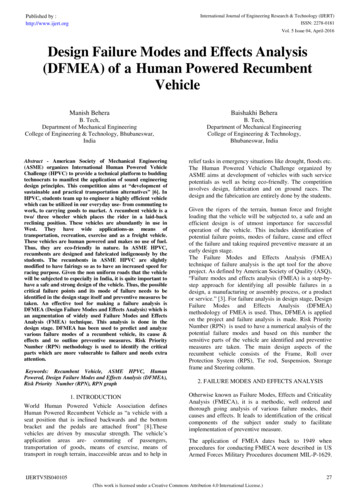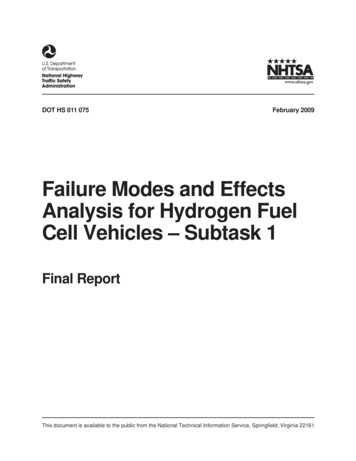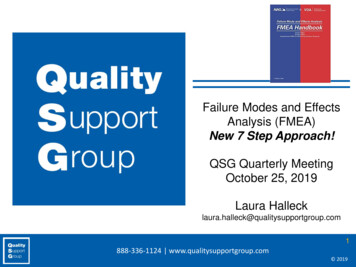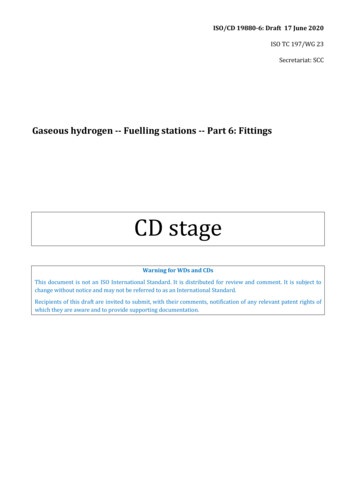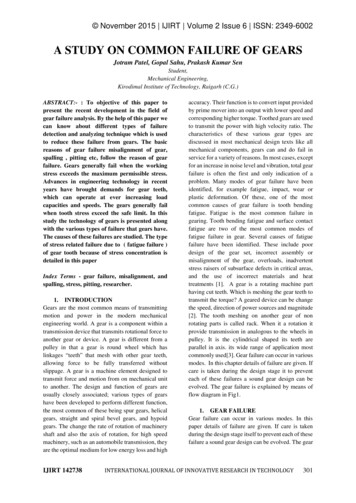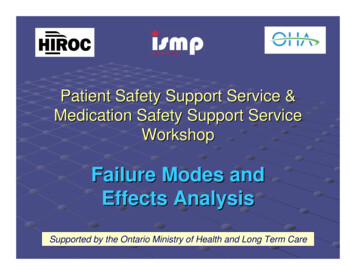
Transcription
Patient Safety Support Service &Medication Safety Support ServiceWorkshopFailure Modes andEffects AnalysisSupported by the Ontario Ministry of Health and Long Term Care
Please silence your communication leashes
Objectives – FMEA Session To introduce the OHA Patient SafetySupport Service and ISMP CanadaMedication Safety Support Service To Describe the origin and utility ofFMEA To Involve participants in an abbreviatedFMEA
ISMP CANADA Vision Independent nonprofit Canadian organization Established for:the collection and analysis of medication error reportsandthe development of recommendations for theenhancement of patient safety. Serves as a national resource for promoting safemedication practices throughout the health carecommunity in Canada.
ISMP Canada Programs CMIRPS (Canadian Medication IncidentReporting and Prevention System)3 partners:o ISMP Canada,o Canadian Institute for Health Information (CIHI)o Health Canada
ISMP Canada Programs Medication SafetySupport ServiceConcentrated PotassiumChlorideOpioids (narcotics) Analyze-ERRMedication SafetySelf-Assessment(MSSA)
Outline Introduction Brief Overview of Human Factors Overview of the Origins of FMEA FMEA steps Practice Sessions Discussion and Wrap Up
Human Factors Engineering 101a discipline concerned with design ofsystems, tools, processes, machines thattake into account human capabilities,limitations, and characteristics
Human Factors Engineering Principles Simplify key processesStandardize work processesImprove verbal communicationCreate a learning environmentPromote effective team functioningAnticipate that human make errors
Human Factors – Guiding PrincipleFit the task or tool to thehuman, not the other wayaround.
FMEA definition FMEA is a team-based systematic andproactive approach for identifying the waysthat a process or design can fail, why itmight fail, the effects of that failure andhow it can be made safer. FMEA focuses on how and when a systemwill fail, not IF it will fail.
Why me ? Why you? Practitioners in the systems know thevulnerabilities and failure points Professional and moral obligation to “firstdo no harm” Increased expectation that we create safesystems
FMEA Origins FMEA in use more than 40 years beginning inaerospace in the 1960s 1970s and 1980s used in other fields such asnuclear power, aviation, chemical, electronicsand food processing fields ( High ReliabilityOrganizations) Automotive industry requires it from suppliers,reducing the after-the-fact corrective actions
FMEA is a tool to: Analyze a process to see where it islikely to fail. See how changes you areconsidering might affect the safety ofthe process.
JCAHO Position JCAHO’s safety standards now includesrequirements for the prospective analysis andredesign of systems identified as having thepotential to contribute to the occurrence of asentinel event (FMEA) JCAHO expects healthcare facilities to setFMEA priorities based on their own riskmanagement experiences or external sources
CCHSA Patient Safety GoalsCarry out one patient safety-relatedprospective analysis process peryear (e.g. FMEA), and implementappropriate improvements /changes.
FMEA versus RCA - when to useFMEA Future (preventative)RCA Retrospective (after the eventor close call)
FMEA StepsStep 1Step 2Select process and assemble theteamDiagram the processStep 3Brainstorm potential failure modesand determine their effectsStep 4Identify the causes of failure modes
FMEA Steps (cont)Step 5Prioritize failure modesStep 6Redesign the processesStep 7Analyze and test the changesStep 8Implement and monitor theredesigned processes
FMEA Process Steps - 1Step 1Select a highrisk process& assemblethe teamStep 2Step 3
Select a high-risk process Internal data – aggregatedata, significant individualevents Sentinel Events CCHSA Patient SafetyGoals ISMP Canada Executive buy-inSelect processes withhigh potential for havingan adverse impact on thesafety of individualsserved.
High Risk Processes - DefinitionThose processes in which a failure ofsome type is most likely to jeopardize thesafety of the individuals served by thehealth care organization. Such processfailures may result in a sentinel event.
High Risk Processes - Examples Medication Use Operative and other procedures Blood use and blood components Restraints Seclusion Care provided to high-risk population Emergency or resuscitation care
Typical FMEA topicsin Health Care Blood administration Admission / discharge / transfer processes Patient Identification Outpatient Pharmacy Dispensing Allergy Information Processing Specimen Collection
Typical Medication Use FMEAs Narcotic use Anticoagulation Insulin or other diabetes drug use Chemotherapy processing Parenteral Electrolyte use Neonatal or pediatric drug useIt is no coincidence that many are high alertdrug use processes
Assemble a team LeaderFacilitatorScribe / RecorderProcess expertsInclude all areasinvolved in theprocess “Outsider” /Naïveperson 6-10 optimal number
FMEA Process Steps - 2Step 1Select a highrisk process& assemblethe teamStep 2Diagram theProcess
Handy Hints:Pick a manageable portion of the the processMake sure the topic is narrow enough of a focus(don’t try to cure world hunger)FMEA should focus on larger high profile, safetycritical areasResource intense to analyze and fixCan apply methodology on other projects without a superteam
Diagram (flow chart) the processDefine beginning and end ofprocess under analysisChart the process as it isnormally doneUsing the collective processknowledge of the team, aflow chart is sketched.
Why diagram the process? Diagrams clarify things between members Narrows the topic – goes from broad topice.g. narcotic use process to narrow topice.g. morphine removed from narcoticdrawer
Narcotic Drug Use ProcessDiagram Basic StepsReceive drugs fromPharmacy vendorCheck drugs intopharmacyDispense to patientcare areaRemove from stockone dose at a timeas patients requestmedicationAdminister drug topatientDocument drugadministration andrecord waste
Narcotic Drug Use ProcessNumber Basic Steps1Receive drugs fromPharmacy vendor4Remove from stockone dose at a timeas patients requestmedication23Check drugs intopharmacyDispense to patientcare area56Administer drug topatientDocument drugadministration andrecord waste
Narcotic Drug Use ProcessSelect One Portion ofProcess at a Time to Diagram1Receive drugs fromPharmacy vendor4Remove from stockone dose at a timeas patients requestmedication23Check drugs intopharmacyDispense to patientcare area56Administer drug topatientDocument drugadministration andrecord waste
Narcotic Drug Use ProcessDiagram the Sub-Process StepsReceive requestfrom Patient CareAreaTechnician pullsdrug from Narcoticvault / cabinetNarcotic andrequest set out tobe checkedPharmacist checksdrug againstrequestTechnicianassembles drug(s)Technician handcarries to thePatient Care Area
Narcotic Drug Use ProcessNumber the Sub-Process Steps3A3B3CReceive requestfrom Patient CareAreaTechnician pullsdrug from Narcoticvault / cabinetNarcotic andrequest set out tobe checked3DPharmacist checksdrug againstrequest3ETechnicianassembles drug(s)3FTechnician handcarries to thePatient Care Area
Notes about Diagramming Once the diagramming is done, the team mayrealize that the topic is TOO LARGE The team may want to re-define the topic to amore manageable portion of the subject, but thelarger diagram will be useful to “see” theinterrelation between different parts of theprocess It is not uncommon for the diagrams to be morecomplex and branched than in our exampleshere (organization is the key)
Narcotic Drug Use ProcessBrainstorm Failure Modes3A3B3C3D3E3FReceive requestfrom PatientCare AreaTechnician pullsdrug fromNarcotic vault /cabinetNarcotic andrequest set out tobe checkedPharmacistchecks drugagainst requestTechnicianassemblesdrug(s)Technician handcarries to thePatient CareAreaRequest never receivedTechnician pulls wrongdrugTechnician forgets to setout on counterPharmacist doesn’t checkPharmacy is closedTechnician doesn’t pulldrugRequest is blankTechnician pulls wrongquantityDrug diverted while sittingout on counterDrug slips off the counteror falls through crackProcess StepsTechnician grabs partialTechnician drops drug orrequestPharmacist checks onlypart of requestTechnician grabs orderfor closed unitTechnician hijacked onway to patient care areaPharmacist checksinaccuratelyTechnician mixes updrugs and requestsTechnician mixes updrugs and requestsPotential FailureModes
Narcotic Drug Use ProcessNumber Failure Modes3A3B3C3D3E3FReceive requestfrom PatientCare AreaTechnician pullsdrug fromNarcotic vault /cabinetNarcotic andrequest set out tobe checkedPharmacistchecks drugagainst requestTechnicianassemblesdrug(s)Technician handcarries to thePatient CareArea1Request never received1Technician pulls wrongdrug22Technician doesn’t pulldrugPharmacy is closed3Request is blank1Technician forgets to setout on counterPharmacist doesn’t check2Drug diverted while sittingout on counter3Technician pulls wrongquantity1Process StepsTechnician grabs partial2Pharmacist checks onlypart of request3Drug slips off the counteror falls through crack1Technician drops drug orrequest2Technician grabs orderfor closed unit3Pharmacist checksinaccurately12Technician hijacked onway to patient care area3Technician mixes updrugs and requestsPotential FailureModes3Technician mixes updrugs and requests
FMEA Process Steps - 3Step 1Select a highrisk process& assemblethe teamStep 2Diagram theProcessStep 3BrainstormPotentialFailureModes
Brainstorm potential failuremodes1. People2. Materials3. Equipment4. Methods5. EnvironmentFailure modes answer the WHAT could go wrong question
Handy HintsFailure Modes are the WHATs that couldgo wrongFailure Mode Causes are the “WHY”sMay be more than one cause for eachfailure
FMEA Process Steps - 4Step 1Select a highrisk process& assemblethe teamStep 2Step 3Diagram theprocessBrainstormPotentialFailureModesStep 4IdentifyCauses ofFailureModes
Identify root causes offailure modes Focus on systems &processes, not individuals Asks why?, not who? Prospective application ofRCA Critical to identify all rootcauses and theirinteractions
Practice Session ONE For your sub-process brainstorm the potentialfailure modes of at least one step Finish one process step before moving on to thenext process stepUse sticky notes for failure modes Next brainstorm the causes of the failure modesUse different coloured sticky notes for the causes Be ready to de-brief the results to the othergroups
Narcotic Drug Use ProcessNumber Failure spreadsheet3A3BReceive requestfrom PatientCare AreaTechnician pullsdrug fromNarcotic vault /cabinet1233FailureModeNumber12Hint: be careful to keepthe numbering!3Potential Failure ModeDescriptionTechnician pulls wrongdrugTechnician doesn’t pulldrugTechnician pulls wrongquantitySingle PointWeakness?Process Steps3FTechnicianassemblesdrug(s)Technician handcarries to thePatient CareArea1Technician grabs partial2Pharmacist checks onlypart of request3Drug slips off the counteror falls through crack3E1Pharmacist doesn’t check2Drug diverted while sittingout on counterTechnician pulls wrongquantityPharmacistchecks drugagainst request1Technician forgets to setout on counter2Technician doesn’t pulldrugPharmacy is closed3DNarcotic andrequest set out tobe checked1Technician pulls wrongdrugRequest never receivedRequest is blank3C2Technician grabs orderfor closed unit3Pharmacist checksinaccurately1Technician drops drug orrequest2Technician hijacked onway to patient care area3Technician mixes updrugs and requests3Technician mixes updrugs and requestsPotential FailureModesPotential Cause(s) Potential Effect(s) ofof FailureFailure
readsheetSpreadsheet123Potential Failure ModeDescriptionTechnician pulls wrongdrugTechnician doesn’t pulldrugTechnician pulls wrongquantityWeakness?FailureModeNumberTechnician pulls drug from Narcotic vault / cabinetSingle PointProcess Step Number: 3 BPotential Cause(s)of FailurePotential Effect(s) ofFailure
Single Point Weakness A step so critical that it’s failure will result in asystem failure or adverse event Single point weaknesses and existing controlmeasures “modify” the scoringSingle point weaknesses should all be acted uponIF effective control measures are in place, it wouldcancel the need to take further action (risk ismitigated)
3Potential Failure ModeDescriptionTechnician pulls wrongdrugTechnician doesn’t pulldrugTechnician pulls wrongquantityWeakness?FailureModeNumberTechnician pulls drug from Narcotic vault / cabinetSingle PointProcess Step Number: 3 BPotential Cause(s)of FailurePotential Effect(s) ofFailureNNNSingle Point Weakness: A step so critical that it’s failure will result in asystem failure or adverse event
EvaluateEvaluatethetheCAUSE(S)CAUSE(S) l FailureMode DescriptionTechnician pullswrong drugSinglePointWeaknesProcess Step Number: 3 B Technician pulls drug from Narcotic vault / cabinetPotential Cause(s) ofFailureNLook alike packagingStorage location tooproximal2Technician doesn’tpull drugNForm is hand writtenand not very legibleTechnician is distracted3Technician pullswrong quantityNpackages are in randomorderPotential Effect(s) ofFailure
Effects of the Failure Modes Review each failure mode and identify theeffects of the failure should it occur May be 1 effect or 1 Must be thorough because it feeds into therisk rating If failure occurs, then what are theconsequences
EvaluateEvaluate thethe EFFECT(S)EFFECT(S) ofof thethe failurefailureFailureModePotential Failure ModeNumber DescriptionTechnician pulls wrongdrug1Technician doesn’t pulldrug2Technician pulls wrongquantity3Single PointWeakness?Process Step Number: 3 B Technician pulls drug from Narcotic vault / cabinetNNNPotential Cause(s) ofFailureLook alike packagingStorage location tooproximalForm is hand written andnot very legibleTechnician is distractedpackages are in randomorderPotential Effect(s) ofFailurePatient receives wrongdrugNursing unit runs out ofdrugNursing unit is over orunder stocked
FMEA Process Steps - 5Step 1Select a highrisk process& assemblethe teamStep 2Step 3Step 4Diagram auses ofFailureModesStep 5BrainstormEffects &PrioritizeFailureModesCalculate RPN
Prioritize failure modes Score frequency of failure mode Score detectability of failure prior to theimpact of the effect being realized Score severity of effect of failure mode
Frequency Also known as occurrence – it is thelikelihood or number of times a specificfailure (mode) could occurFrequency 5
DetectabilityThe likelihood of detecting a failure or the effectof a failure BEFORE it occursDetectability DescriptionAlwaysLikelyUnlikelyNeverScore1234Many events are detectable or obvious afterthey occur but that is not a FMEA detectable eventby definition.
Examples of Detectability Break away locks Emergency drug boxes with pop uppin Ampoules Low battery alarm
SeverityThe seriousness and severity of the effect (to theprocess or system or patient) of a failure if it shouldoccur.Severity DescriptionNo effectSlightModerateMajorSevere / CatastrophicScore12345Score based upon a “reasonable worst case scenario”
If severity 5 alwaysaddress ite.g. Potassium Chloride (KCl)The severity 5 but the frequency 1
Calculate the Risk Priority Number Determine the impact of the failure on the patient orthe system using the severity, frequency anddetectability parameters Multiply three scores to obtain a Risk Priority Number(RPN) or Criticality Index (CI) Also assign priority to those with a high severity scoreeven though the RPN may be relatively low
Handy HintsUse group discussion and the expertise of theteam membersSince ratings are multiplied, one or two pointscan have a significant impact on RPN. Don’tagree just to keep the process goingTalk things outIf no consensus is reached, the team shoulduse the higher rating. (better to have morework than to miss a severe failure mode)Use a “reasonable worst case” scenario
Practice Session –TWO1. Brainstorm potential failure effects2. Assign a number to:oooFrequency,DetectabilitySeverity,3. Determine the RPN number for thefailures you identifiedo Use the flipchart or formo Be prepared to debrief
RPN FREQUENCY1 Yearly, 5 Hourly DETECTABILITY SEVERITY1 Always, 4 Never1 No Effect, 5 Severe
AssessAssesscurrentcurrent pact themthemFMEA Subject: Narcotic Drug Distribution2aTechnician doesn’tpull drugN2b3aTechnician pullswrong quantityNnursing unit runsout of drugnursing unit isover or understockedRPN1bDetectionNpatient receiveswrong drugFrequency1aTechnician pullswrong drugSeveritySinglePointWeaknessProcess Step Number: 3 B Technician pulls drug from Narcotic vault / cabinetProcess Step Description:EffectiveControlFailureMode Potential FailurePotential Effect(s) Potential Cause(s) of MeasureNumber Mode Descriptionof FailureFailurein PlaceLook alike packagingN53460Storage location tooproximalN52220Form is hand writtenand not very legibleN24216Technician isdistractedN24324packages are inrandom orderN24324Action / DateOR reason fornot actingWho isresponsible?In a real FMEA, a spreadsheet can besorted in numerical order by RPN
FMEA Process Steps - 6Step 1Select a highrisk process& assemblethe teamStep 2Step 3Step 4Diagram auses ofFailureModesStep 5Step 6BrainstormEffects &PrioritizeFailureModesRedesignTheProcess
Redesign the process Apply strategies to decreasefrequency, decreaseseverity, or increasedetection Goal: prevent harm to thepatient Simplification, automation,standardization, fail-safemechanisms, forcingfunctions, redundancy
Evaluating Redesign Options Don’t just pick training and policy development.They are basic actions but not very strong orlong lasting. Go for the permanent fixes when possible. Elimination of the step or the function is a verystrong action. Most actions are really controls on the system. Sometimes your team might have to acceptsome of the failure modes as “un-fixable”.
Three ways to improve safetySafety for DummiesIncrease DetectabilityDecrease FrequencyReduce Severity
HFE Strength of possible actions Use stronger actions where possiblePhysical and architectural over policy andtrainingCheck lists, forcing functionsStandardization, simplificationCognitive aids, usability testing
FMEA Subject: Narcotic Drug DistributionTechnicianpulls wrongdrugStorage locationtoo proximal12Techniciandoesn’t pulldrugNForm is handwritten and notvery legibleTechnician isdistracted23nursing unitruns out ofdrugTechnicianpulls wrongquantityNnursing unit isover or under packages are instockedrandom orderEffectiveControlMeasurein PlaceNNNNNRPNNpatientreceives wrong Look alikedrugpackagingPotentialCause(s) ofFailureDetectionPotentialEffect(s) everityFailureModeNumberSingle Point Weakness?Process Step Number: 3 B Technician pulls drug from Narcotic vaultProcess/ cabinetStep Description:Action / Date ORreason for notactingWho isresponsible?5CSPharmacist5CSPharmacist22224442 20 As aboveImplement preprinted par levelorder form by2 16 7/31/04Implement balancesheet (order lines dispense lines) by3 24 7/31/04Par level processwill solve this(ordering in3 24 standard quant)CSPharmacistCSPharmacistCSPharmacist
FMEA Process Steps - 7Step 1Select a highrisk process& assemblethe teamStep 2Step 3Step 4Diagram auses ofFailureModesStep 5Step 6Step 7BrainstormEffects &PrioritizeFailureModesRedesignTheProcessAnalyze &Test theChanges
Practice Session –THREE For the highest RPN’s identified,brainstorm actions for change Use high leverage strategies asmuch as possible Identify responsibility for action
Analyze and test the changes Conduct FMEA of redesigned process Use simulation testingwhenever possible Conduct pilot testingin one area or onesection
FMEA Process Steps - 8Step 1Select a highrisk process& assemblethe teamStep 5BrainstormEffects &PrioritizeFailureModesStep 2Step 3Step 4Diagram auses ofFailureModesStep 6RedesignTheProcessStep 7Step 8Analyze &Test theChangesImplement &Monitor theRedesignedProcesses
Implement and monitor theredesigned process Communicatereasons for processchanges Find change agents Define process andoutcome measures Share results Monitor over time
Tips (gold nuggets) Start small and get success early onNarrow Narrow NarrowCan use different team members from thesame department for different parts of theprocess (substitution of team players)versus RCA not able to do that
Beware of Stagnation Reasons FMEA projects might stagnate:We have never done it that wayWe are not ready for that yetWe are doing all right without itWe tried it once and it did not workIt costs too muchThat is not our responsibilityIt would not work around here anyway
Gains using FMEA Safety minded cultureProactive problem resolutionRobust systemsFault tolerant systemsLower waste and higher quality
‘Emphasis on preventionmay reduce risk ofharm to both patientsand staff.’Failure Modes and Effects Analysis (FMEA), IHI and Quality HealthCare.org, 2003
References McDermott- The Basics of FMEA Stamatis – Failure Mode Effect Analysis: FMEAfrom Theory to Execution (2nd ed) JCAHO – Failure Mode and Effects Analysis inHealth Care. Proactive Risk Reduction Manasse, Thompson (Lin, Burkhardt) -LogicalApplication of Human Factors In Process andEquipment Design (in press).
Technician assembles drug(s) Technician hand carries to the Patient Care Area Pharmacist checks drug against request Narcotic and request set out to be checked Technician pulls drug from Narcotic vault / cabinet 3A 3B 3C 3D 3E 3F Request never received Pharmacy is closed Request is blank Potential Failure Modes Process Steps Technician doesn .

